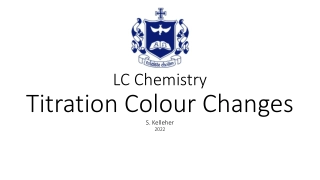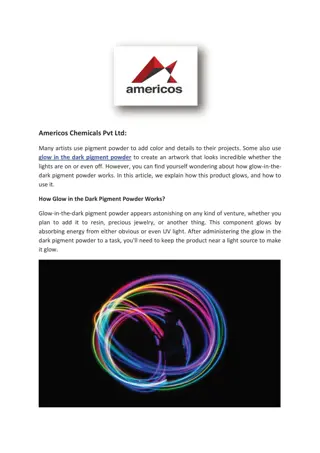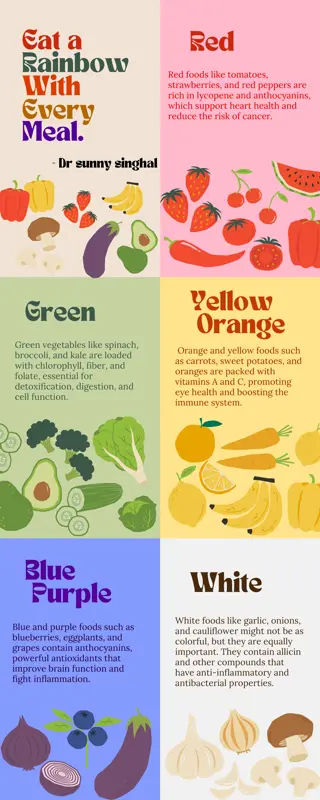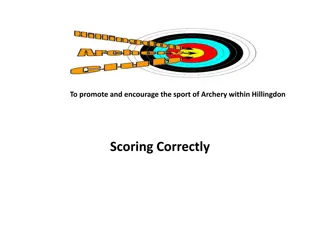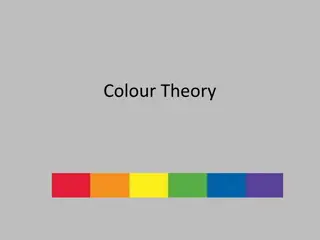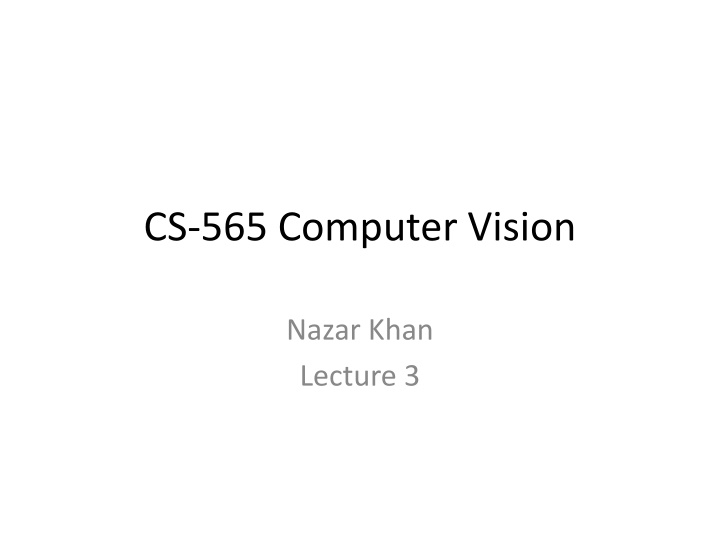
The Fascinating World of Colour Science in Computer Vision
Delve into the interdisciplinary realm of colour science and its significance in calibrating devices like scanners and digital cameras. Explore the physical background of visible light, electromagnetic waves, and the seven colours of the visible spectrum.
Download Presentation

Please find below an Image/Link to download the presentation.
The content on the website is provided AS IS for your information and personal use only. It may not be sold, licensed, or shared on other websites without obtaining consent from the author. If you encounter any issues during the download, it is possible that the publisher has removed the file from their server.
You are allowed to download the files provided on this website for personal or commercial use, subject to the condition that they are used lawfully. All files are the property of their respective owners.
The content on the website is provided AS IS for your information and personal use only. It may not be sold, licensed, or shared on other websites without obtaining consent from the author.
E N D
Presentation Transcript
CS-565 Computer Vision Nazar Khan Lecture 3
A Note on Pre-Requisites Stop obsessing about it! We will cover background as we go along. Some material has been added to the course folder.
Topics to be covered Motivation for Studying Colour Physical Background Biological Background Technical Colour Spaces
Motivation Colour science or colour vision highly interdisciplinary area influences from physics, biology, psychology, physiology, electrical engineering, computer science, and mathematics Understanding the mechanisms of colour perception is crucial for calibrating scanners, colour monitors, colour printers, and digital cameras Many brilliant minds have done research on colour Newton, Goethe, Gra mann, Maxwell, Helmholtz, Schroedinger. Not always successful
Physical Background The wave length is the distance between two consecutive points with the same phase. Source: http://en.wikipedia.org/wiki/Wavelength Electromagnetic waves propagate with the speed of light c = 299, 792, 458 m/s in vacuum). If f denotes their frequency, wave length is defined via c = f. Visible light consists of electromagnetic waves with wave lengths between 380 and 750 nm (nanometers) Light is emitted from atoms when outer electrons change their orbits and loose energy. = 9 1 10 nm m
Physical Background Visible range of the electromagnetic spectrum is the main range in which the sun rays can pass the atmosphere The visible range is not the same for all animals Insects can perceive ultraviolet light very well Humans whose eye lenses have been removed by a surgeon do also perceive ultraviolet light down to 300 nm The visible spectrum contains seven colours red, orange, yellow, green, blue, indigo, violet with decreasing wavelength or increasing frequency
Physical Background Colours that we usually perceive are a mixture of numerous frequencies. Pure spectral colours consisting of a single frequency are rare They exist e.g. in rainbows, in light rays that pass through a prism, and in lasers. Source: http://www.theinquirer.net/IMG/847/948 47/light-split-into-spectrum-by-prism.jpg
Physical Background However, biological and technical systems do not exploit all frequencies of a perceived colour They use a more compact representation. To understand this, let us consider the biology of colour perception.
Biological Background The Eye The Retina http://www.soundandvision.com/images/ archivesart/204eye.3.jpg http://www.pennmedicine.org/health_info/ body_guide/reftext/images/retina_section.jpg
Biological Background The human retina consists of two classes of photo receptors: 120 million rods distributed over the whole retina. Multiple rods are connected to a single nerve. 6 million cones, mainly in the centre of the retina. Each cone is connected to its own nerve end. The Retina http://www.pennmedicine.org/health_info/ body_guide/reftext/images/retina_section.jpg
Biological Background For night vision, rods dominate. Very sensitive, but allows only poor sharpness and no colour perception Day vision is dominated by cones. Low sensitivity, but very good perception of sharpness and colours. Humans can distinguish about 40 different grayscales, but 2 million colours. Our focus day vision.
Biological Background Humans have three different types of cones (L, M, S) being sensitive to different wavelength ranges: Long red Medium green Medium blue. The sensitivity characteristics are almost identical for all humans.
Biological Background Visual impression of a colour depends on its effect on the 3 types of cones. Specifically: The colour produces 3 response values (one for each kind of cone) These are called tri-stimulus values Mathematically speaking ( ) ( ) QS = Incoming_l ight Blue_Curve d
Biological Background Colours are no objective physical reality. Colour perception is a biologically useful interpretation of the physically existing wave length spectrum.
Technical Colour Spaces The RGB Colour Space Additive Model Primary colour basis red (R = (1, 0, 0)), green (G = (0, 1, 0)), blue (B = (0, 0, 1)) All colors are generated as linear combinations of these 3 primary colours. This yields the so-called RGB Cube
Technical Colour Spaces Every colour has a complementary colour such that adding them gives white. The complementary colour is at the opposite side of the cube.
Technical Colour Spaces Colours can be blended by linear combinations of the primary colors in the RGB space. Computer screens use this kind of additive colour blending.
Technical Colour Spaces The CMY Color Space Used by printers and copiers that place colour pigments on white paper. In contrast to the additive RGB model, the CMY model is subtractive. Colour impressions are determined by the colour that is subtracted (absorbed into the white paper) from white light. Complementary to RGB Basis: cyan (C=(1,0,0)), magenta (M=(0,1,0)), and yellow (Y=(0,0,1)) In the RGB model, an equal combination of the primary colours R, G, B gives white. In the CMY model, an equal combination of the primary colours C, M, Y creates ? black.
Technical Colour Spaces Colours can be blended by linear combinations of the primary colors in the CMY space. Printers use this kind of subtractive colour blending.
Technical Colour Spaces The CMYK Colour Space Extension of CMY to include black (K) as fourth colour Useful for colour printers that print large amounts of text in black Conversion formula for CMY to CMYK
Technical Colour Spaces The HSV Colour Space
Technical Colour Spaces The HSV Colour Space Based on a cylindrical polar coordinate system with hue, saturation and value as coordinates Hue (H) polar angle in the horizontal plane red: 0; green: 120; blue: 240 saturation (S) radius in the horizontal plane gives distance of the colour to the next grey tone value (V) vertical axis in the coordinate system defines how dark or bright a colour is
Technical Colour Spaces HSV can offer advantages when illumination changes appear Typical changes global multiplicative changes: global illumination changes local multiplicative changes: shadow, shading local additive changes: specular highlights The H and S channels are photometric invariants: H is invariant under all these three changes. S is invariant under global and local multiplicative changes. V is not invariant under any of these changes.
Technical Colour Spaces The YCbCr Colour Space Used in video and digital photography systems digital PAL and NTSC television, JPEG and MPEG compression separates the colour image into a luma component Y that is basically a greyscale version of the colour image a chroma component Cb that measures deviation from grey in blue yellow direction a chroma component Cr that measures deviation from grey in red cyan direction
Color Spaces and Image Compression The luma channel Y should be stored in high resolution, while the chroma channels Cb and Cr can be subsampled without significant visual deterioration. This is exploited in the JPEG compression standard.
Summary Visible light consists of electromagnetic waves in the range from 380 to 750 nanometers. Illuminated real objects emit a mixture of different wave lengths. Human colour perception is based on three types of cones that are sensitive in different frequency bands. An additive blending of the three primary colours red, green and blue is used for creating other colours. This is realised in the RGB colour space which is a very frequently used additive colour space for digital cameras and monitors.
Summary The CMY and CMYK spaces are subtractive colour spaces for printers and copiers. The HSV colour space represents colours in a cylindrical polar coordinate system. This can be useful when illumination changes appear. The YCbCr representation separates luma from chroma information. One can subsample the chroma channels without severe visual degradation. Useful for image compression.

